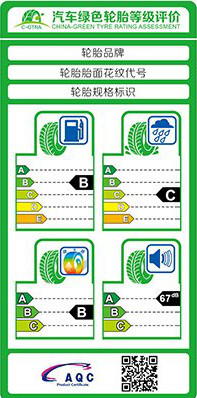Chinese tyre labelling comes to the fore
At least two different labelling options available in the People’s Republic
In 2012 the EU introduced plans to support consumers with better information about a tyre’s noise, wet-braking and rolling resistance performance. Since then, Japanese, South Korean and US variants have been either mooted or implemented. However, the world’s largest tyre market (China), is also close to releasing its own labelling system – or should that be systems? Tyres & Accessories saw two labelling variants during the recent Tire+ exhibition in Shanghai and discussed the subject with a number of firms exhibiting there.
As we have seen, China has decided to gradually introduce uniform tyre labelling and examples of this are already visible. In practice, this means the implementation of a voluntary labelling system in 2017, but with some sources reporting that this will become mandatory as of 2018. However, this isn’t the whole story. While the government might want labels on tyres by the end of 2018, at least two different schemes producing two different labels were visible in Shanghai. One source told T&A there are at least three versions in the offing.
As in the case of other international tyre labelling examples, Chinese labels have obstacles to overcome in terms of legal definition and testing regime. The CRIA-sponsored label takes the most direct approach by validating definitions and standards that already exist. In other words, if your product qualifies for a European tyre label, this data can be used on the Chinese tyre label. Owing to the fact that the China Rubber Industry Association is the domestic industry’s largest and most influential association (not to mention the fact that it is quasi-governmental), CRIA is well-placed to roll-out the new standard.
Tyre label up close
To all intents and purposes, the Chinese label looks like a white version of the European label, bearing the CRIA logo.
However, while much of the layout and criteria remain the same, the main difference about the Chinese tyre label, apart from the language, is the addition of a QR code. This simple, but powerful feature means consumers can access further information about their tyres one the smartphones via the Internet. And of course this also means the label (or the virtual version, at least) can be updated in real-time – something that is particularly helpful in the case of recalls and other related road safety issues.
A second version of the Chinese tyre label comes in the form of the snappily named “China Great Tyre Rating Assessment” is appropriately green in colour and – like the CRIA version – features a QR code. The main difference is the fact that the CGTRA design features treadwear as a fourth category graphically displayed on the label.
So which label are Chinese tyre companies backing? Talking to various companies during Tire+ reveals two key approaches to the label options: backing a horse or waiting it out. Those that have backed a particular horse have already started exhibiting it on products. In most cases this is the CRIA option. Several other firms – including some of the biggest in China – are waiting to see what they have to do before committing either way. Their view is that they certainly don’t want to have to invest in paying for more than one label if they can possibly avoid it.
The costs associated with Chinese labelling depend very much on which option you go for. If the label variant requires its own testing, this is clearly a far more expensive option. However, the CRIA system – which is based on validating existing tyre label test data – will inevitably more much affordable. Add in the fact that this association based system has integrated links to industry and it seems likely that that this label will prevail ahead of its one or two competitors.

(The more complex “Green” tyre label includes a tread wear graphic in addition the three criteria from the European tyre label we are all familiar with)
- Tireworld Insight: Domestic tire makers eye overseas expansion
- Tireworld Insight: Price disparity severe between China's rubber exports and imports
- Tireworld Insight: China tire exports dependent on US market performance
- Tireworld Insight: SHFE rubber expected to move in tight range in short-term
- Tireworld Insight: Rubber futures to test near-term resistance at 15,000 yuan/tonne
- Tireworld Insight: China’s tire industry on track of rapid growth






